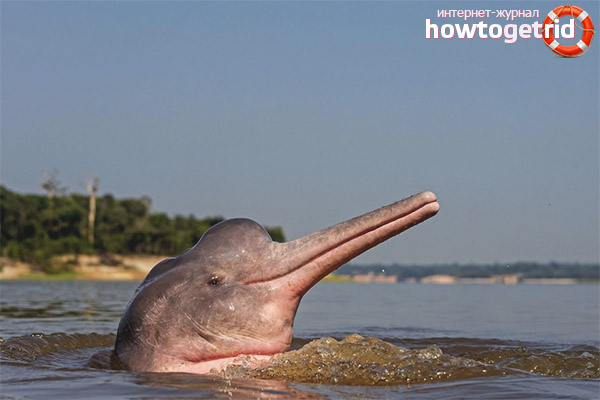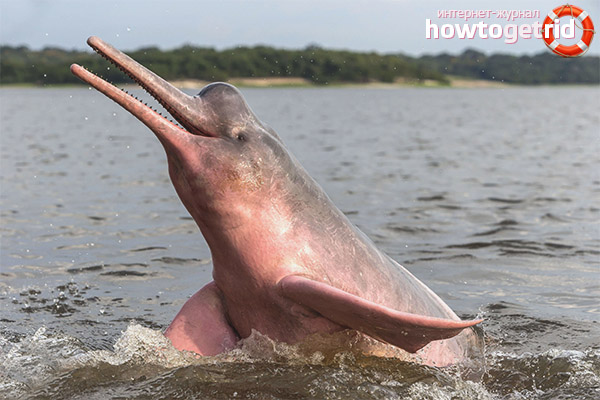The content of the article
In the world there are many unusual animals, of which I know far from all. These include the Amazonian dolphin, also called buoto. You will not find representatives of this species in zoos or dolphinariums, because in captivity they usually live no longer than 3 years. At this age, they still do not have puberty. Therefore, it is impossible to obtain offspring of these animals in captivity.
Representatives of this species are not amenable to training; nevertheless, they can be tamed quite simply. When kept in an aquarium, they begin to show aggression. Bowtos differ from their relatives not only in their character, but also in their external characteristics. Their peculiarity lies in the fact that after reaching a certain age, their color begins to change. Coloring can be different. For example, bright red or very dark. As a rule, the upper body of these amazing animals is painted in bluish or gray, while the lower half is pink in color. The body length can be 2.5-3 m. These are the largest river dolphins. The weight of an adult is about 200 kg.
They have a narrow muzzle, and the tail is rather thin. But the middle of the body is complete. Their beak is long, somewhat curved, their foreheads are steep. There are bristles on the beak. There are up to 108 teeth that are erased due to solid food. Their eyes are small, and the lenses and cornea are yellow. Thanks to this, the eyes are protected from the sun. Instead of a dorsal fin on their back, they have a hump. These dolphins also have a neck, and they can turn their heads. They have very thick cheeks, due to which the animal cannot see anything, therefore, while searching for food at the bottom, they swim upside down.
Where dwells
Amazonian dolphins prefer to live in the same place. But they are characterized by seasonal migrations. If the water level drops in a pond, they usually look for a deeper place. During the period when the river floods, they like to play on the flooded floodplain. When the rainy season begins, these dolphins can migrate to another river.
Inii prefer to live alone. Groups are collected only during breeding.
Breeding
Often you can see the mother and the cub together. Scientists have not yet fully studied the reproduction of this species. It is believed that males fight for a female who lives after the birth of a baby in shallow water. There are no predators, it is easier to find food, and it is easier for a cub to swim to the surface behind a breath of air. During the year, the mother feeds the little dolphin with milk, but takes care of him for about 2 more years. Puberty occurs at 5 years. At this age, they gather in packs, fighting for the chosen ones.
Behavior

They live alone, so there is no hierarchy. But at a meeting, dolphins communicate with each other through various sounds and echolocation. They lead an active lifestyle. The swimming speed is about 3 km / h, but at the same time, Amazonian dolphins maneuver very well. Underwater representatives of the species can be up to 2 minutes. Crabs and fish are caught under a layer of silt. They seek food at the mouths, near the shore or waterfall. Since the water in the Amazon is cloudy, they get food through echolocation and hearing.
Representatives of this species can eat 12 kg of food per day. This is mainly fish, but there may also be a turtle or a crab.Sometimes they trap whole schools of fish into traps, combining with other dolphins, as well as with large otters. Piranha is included in their diet. Thanks to inii, the abundance of this dangerous fish is controlled.
Amazonian dolphins are playful and curious in nature. They never abandon their wounded brothers.
Enemies
Legends
Locals are sure that these animals are sacred. According to legend, they turn into a youth, and abduct women with the aim of procreation.
Another legend says that Inia is an evil sorceress who comes to young people in the form of a beautiful girl with long hair. She lures them to the river, and then drowns.
Video: Amazonian Dolphin (Inia geoffrensis)










Submit